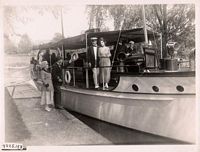

Everybody's Girl (1918) Vitagraph Co. of America. A Blue Ribbon Feature. Distributor: Greater Vitagraph. Presenter: Albert E. Smith. Director: Tom Terriss. Scenario: A. Van Buren Powell. Camera: Robert A. Stuart. Cast: Alice Joyce, Walter McGrail, May Hopkins, Percy Standing, W.T. Carlton, Victor Stewart, Bernard Siegel. 5 reels This film appears to be LOST
 | Still photo. Thanks to Derek Boothroyd for this scan Click on the thumbnail for a larger view |
| Florence | Alice Joyce |
| Ella | May Hopkins |
| Blinker | Walter McGrail |
| Bill | Percy Standing |
| Oldport | William Carleton |
| Blinker's servant | Victor Stewart |
| Prop. of millinery shop | Bernard Siegel |
One of O. Henry's pleasing little stories which Vitagraph has worked into a six-reel feature, starring Alice Joyce with a strong supporting company. The yarn is full of human interest and has not been mutilated to make it adaptable to the screen. The scenes are familiar ones around New York and at Coney Island and they will appeal to film fans of all classes.
Florence (Alice Joyce) and Ella (May Hopkins) are milliners in poor circumstances and share a room in an apartment in Brick Dust Row, a tenement house neighborhood. The girls meet their "gentlemen friends" in the park and elsewhere and are strong for making chance acquaintances, as Ella explains, they are easily able to recognize and dismiss any "fresh" ones.
On the way to Coney Island, by boat, they meet Blinker, a millionaire, who immediately falls in love with Florence. They look at things from different angles and have several misunderstandings. But Blinker is on the level and, in spite of his wealth, is a democratic sort of chap. An accident on the boat on one of these trips brings the pair close together and Blinker declares his love for Florence and is accepted.
The subtitles have bren cleverly written in up-to-date slang and are all amusing. The photography is exceptionally good, with many pleasing close-ups of the principals. The picture was directed by Tom Terriss and has been well handled technically. There are a number of interesting and picturesque scenes, which, while they have no direct bearing on the story, add to the general effectiveness of the picture. "Everybody's Girl" is one of the best Vitagraph program features which has been issued by this organization for some time.
WIRE REPORTS--EAST
| Box Office Value | Fair |
Exhibitor Comments: "Star good, Story poor."
NAT'L BOARD OF REVIEW REPORT
| Entertainment | Good |
| Story | Good |
| Acting | Good |
| Photography | Good |
| Technical Handling | Good |
| Settings | Good |
| Moral Effect | Wholesome |
"EVERYBODY'S GIRL"
Vitagraph Presents Alice Joyce in a Charming Story of New York Life Based Upon O. Henry's "Brick Dust Row."
| Florence | Alice Joyce |
| Blinker | Walter McGrail |
| Ella | May Hopkins |
| Bill | Percy Standing |
| Oldport | W.T. Carleton |
Directed by Tom Terriss
The Story: Florence is a little milliner who shares a room in "Brick Dust Row" with Ella, a fellow worker. It is all the home she has and the girls have to receive their company in the parks because there is no reception room, the millionaire owner of the Row having sublet the parlors. They see no harm in chance acquaintances. Then Florence meets Blinker, and real love comes into her life; but Blinker learns of what to him seems her promiscuous acquaintances and makes it plain that he cannot marry such a woman. There is a fire on the excursion boat on which they are traveling, and Bill, a gun-packing husky, who has constituted himself Florence's champion, saves them both. Then he learns Blinker's attitude, and a visit to the young millionaire owner of the Roy shows Blinker that his own greed is basis for Florence's actions and a changed Row is Florence's wedding present.
"EVERYBODY'S GIRL"
Vitagraph Production of O. Henry Story with Alice Joyce Will Make Many Friend
Reviewed by Edward Weitzel.
SOUTH AMERICA and the Far West were favorite fields for character and plot with O. Henry, but a number of his best stories are about New York and the people that are continually striving to rise above their lowly surroundings. "Everybody's Girl," produced by the Vitagraph, with Alice Joyce as the heroine, and directed by Tom Terriss, is not only a bully bit of romance but it turns the light of O. Henry's sympathetic soul upon a phase of New York City life that explains why so many young girls drift away from home influences when forced to live in one room and meet their men friends on the streets.
Florence is a pretty, healthy-minded young working girl who shares a room in Brick Dust Row with her friend Ella, and goes out and sits in the park when she wants to meet her beau. Ella is forced to do the same thing. The parlor of their rooming house has been sublet, and there is no other place to go. Both girls have picked up chance acquaintances and gone to the theatre with them without being made to pay too dearly for their fun. One day, on a Coney Island boat, Florence starts a flirtation with a wealthy young chap who turns out to be the owner of Brick Dust Row. Their romance ends happily, but Florence almost loses young Blinker, when she confesses about her chance acquaintances. He is finally made to see that it is mostly his fault in lot giving the lodgers the use of the parlor.
There are other characters and incidents in the story that strengthen it dramatically. The doings of Bill, a gang leader, who is saved from the police by Florence, and who becomes her protector, and the husband of Ella, are among the most interesting features. With the exception of an entirely unnecessarily and badly directed fire episode on the boat the picture is expertly produced.
Alice Joyce makes it easy to believe in the character of Florence, and that the young millionaire has not done a rash act in marrying her. This is an achievement of which any actress might be proud. May Hopkins as Ella, Walter McGrail as Blinker and Percy standing as Bill are the principal members of a uniformly competent support.
Last revised October 1, 2010